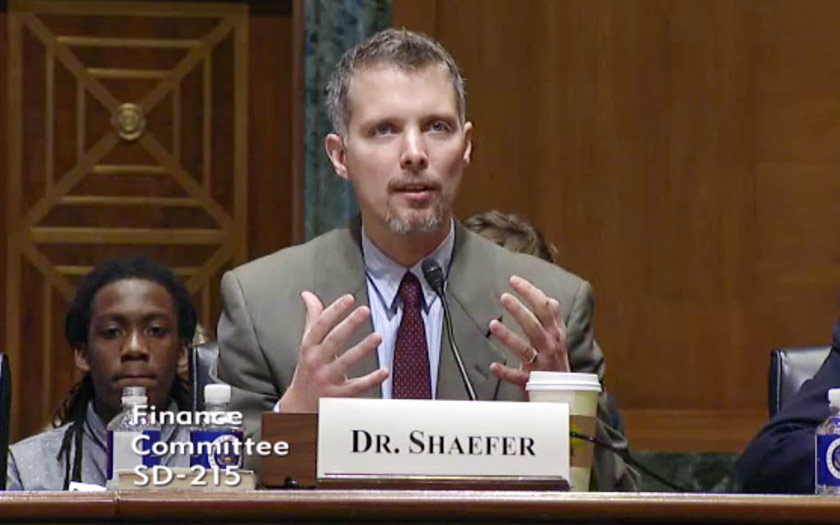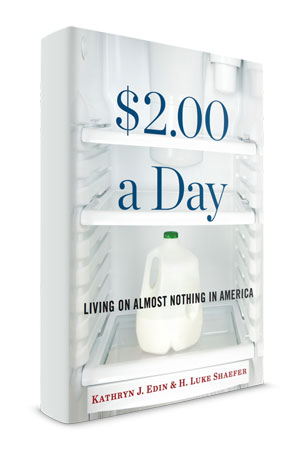
On Tuesday, September 1, Houghton Mifflin Harcourt published $2.00 a Day: Living on Almost Nothing in America. Written by Luke Shaefer and Kathryn Edin, the book movingly documents the troubling rise of extreme poverty in the wake of America’s 1996 welfare reforms.
By the end of the subsequent week, $2.00 a Day had attracted a half-dozen complimentary reviews from some of America’s most prominent media outlets.
In a review for The New York Times, William Julius Wilson described it as a call to action. “[O]ne hopes it will accomplish what Michael Harrington’s The Other America achieved in the 1960s—arousing both the nation’s consciousness and conscience about the plight of a growing number of invisible citizens,” Wilson wrote.
By the end of the following month, policy leaders were demonstrating a growing interest, as well.
Senator Orrin Hatch (R-UT) invited Shaefer to testify before the U.S. Senate Finance Committee at a special hearing on welfare and poverty in America. At that hearing, Hatch described poverty as “crushing,” “remorseless,” and “a critical challenge for our nation,” and expressed a willingness and desire to work across the aisle to address it.
And by the end of the third month, $2.00 a Day was recognized by The New York Times among the 100 most notable books of the year.
When Shaefer sits down to discuss the work some six months after its publication, there’s a rumor that his book has inspired a $2 billion Obama Administration proposal to establish a new program, the Emergency Aid and Service Connection. Designed to reach families on the brink of crisis, the initiative would provide funds to states to offer short-term assistance to struggling families before their situations decline.
Shaefer confirms the news, and says they’ve heard of other items in the President’s budget that are inspired, at least in part, by the book’s findings, as well.
“Now are they going to become law?” Shaefer asks. “That’s a whole ’nother question, of course.”
Just what was it about $2.00 a Day that captured the attention of so many Americans? Likely a few things.
In 2010 the noted sociologist Kathryn Edin, best known for her ethnographic observations of the lives of low-income families, began to notice what felt like a new trend: an increase in the number of Americans with almost no cash income. She turned to Shaefer, a poverty researcher and self-proclaimed “data nerd,” to investigate.
Shaefer himself turned to the most rigorous source of income data he knew: the U.S. Census Bureau’s Survey of Income and Program Participation, known as the SIPP. While he cautions that it’s “far from perfect,” the SIPP captures more income among poor families than any other source available.
Adapting the $2.00-a-day metric used by the World Bank to monitor global poverty, Shaefer discovered that since America’s 1996 welfare reforms, the number of households with children reporting cash incomes below the $2.00-per-person, per-day threshold in any given month had more than doubled, with the biggest increase among families experiencing extended periods of poverty. What happened in 1996? Welfare reform replaced Aid to Families with Dependent Children (AFDC) with Temporary Assistance for Needy Families (TANF), a term-limited cash assistance program administered by states.
Factoring in non-cash sources of support, like food stamps and housing subsidies, makes a big difference, he says. But even then it looked like things were still very much heading in the wrong direction.
Of course, as a true data nerd, Shaefer was compelled to look at other sources of data, as well.
He looked at emergency food assistance records, homelessness reports, food stamp administrative data, and even the number of plasma donations (many low-income Americans sell plasma for cash). All pointed to a worsening of conditions among America’s poorest families with children.
“We tried to base our case on a lot of different forms of data with a lot of different strengths and weaknesses,” says Shaefer. “When they all point in the same direction, it increases your confidence that what you’re seeing is a real trend.”

Trend confirmed, the pair then went to food banks and homeless shelters, and worked with research collaborators in the communities they were studying, to find families living in $2.00-a-day poverty in hopes of learning more about their situations.
How did they find themselves in circumstances like this? What did they do to survive? If they had access to in-kind benefits, did it matter that they had no cash? And what were the long-term consequences of extreme poverty?
Rae McCormack (names changed), who lost her job at WalMart when she lost access to transportation. Jennifer Hernandez, an asthmatic who became sick while cleaning abandoned homes all winter. Jessica Compton, who donated plasma as much as ten times a month.
Their stories, says Shaefer, are the main reason people have been so moved by the book.
What’s next for Shaefer? Quite a bit.
“There has continued to be a fair amount of interest in the book and work,” he says. In fact, over the next ten months Shaefer has been invited to share the work with more than a dozen groups, including private companies, professional associations, non-profit social service providers, and government agencies.
Beyond that, Shaefer is hoping to work with colleagues on related research projects and with policy leaders on evidence-based reforms.
The block-grant structure of TANF, which is up for reauthorization, has created “perverse incentives for states,” says Shaefer. Instead of spending TANF funds on cash assistance for needy families, many states spend them on scholarships, foster care, and social service programs they were likely to run anyway, easing state budgets. Thus, in many parts of the country, he says, TANF “has become welfare for states, not for people.”
Shaefer also hopes to work on new legislation to significantly expand the number and range of subsidized jobs in struggling communities across the country.
While the subjects of $2.00 a Day would have benefitted from cash assistance, and should have received it, says Shaefer, they dreamed of living-wage work that connected them to society.
“This is terribly unempirical,” he confesses, “but I think a core human impulse is to want to make a contribution to the world. To put your mark on it and say look...I rebuilt that house, or I cleaned that apartment.”
“Obviously we don’t want families to go hungry,” says Shaefer, but we ought to find ways to create social welfare programs “that enhance dignity, rather than diminish it.”
By Erin Spanier for State & Hill, the magazine of the Gerald R. Ford School of Public Policy
Below is a formatted version of this article from State & Hill, the magazine of the Ford School. View the entire Spring 2016 State & Hill here.